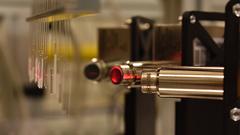URL: https://www.desy.de/news/news_search/index_eng.html
Breadcrumb Navigation
DESY News: Measurements at PETRA III show the uptake of a co-enzyme by individual cells
News
News from the DESY research centre
Measurements at PETRA III show the uptake of a co-enzyme by individual cells
For the study, which has now been published in the journal Antioxidants, the team led by experimental physicist Florian Grüner of the University of Hamburg examined Q10 molecules which they had labelled using iodine atoms and which became visible after these labels had been excited by X-rays, causing them to emit X-ray fluorescence photons (“X-ray echo”). As a result, it was not only possible to confirm the uptake of the enzyme by the cells. “We were also able to determine the spatial distribution of Q10 within the individual cells and to investigate how the uptake varied from one cell to the next. Interestingly enough, every single cell appeared to absorb Q10 whereby this depended on their respective sizes,” says the principal author and project leader Theresa Staufer, who is also co-leader of the group. For some time now, Grüner’s group has been focusing on refining X-ray fluorescence imaging so that it can be used even better as a tool for investigating the effect of molecular drug candidates in biological tissue samples.

The results of this refined method can be found in a number of publications, but also in patents. Next, the research is to be extended to the preclinical stage – i.e. developing new drugs. Together with other groups from the Department of Physics at the University of Hamburg, but also scientists from the University Medical Centre Hamburg-Eppendorf (UKE), Grüner’s group is planning to investigate labelled immune cells in chronic conditions such as Crohn's disease. Another project is focusing on anti-cancer agents, investigating whether these reach the tumour in large enough quantities and whether they also penetrate inside the tumour. The group recently received government funding for this research. There are also plans to apply the findings to studies on hepatitis and kidney diseases. Another project intends to track nanoparticles carrying mRNA, a topic that has been of considerable interest since the development of mRNA vaccines. All these projects rely on brilliant X-rays such as those generated at PETRA III.
“This research has enormous potential, which can be exploited above all through a close cooperation between the physics department of the University of Hamburg and the UKE. However, cooperation within Hamburg as a centre for science is just as important because we have a unique research infrastructure here, such as the facilities operated by DESY,” says Florian Grüner. For the current study alone, numerous partners played a crucial role: the Hamburg Fraunhofer Institute CAN labelled the Q10 molecules, and the X-ray fluorescence was measured in collaboration with a team from DESY’s PETRA III synchrotron, one of the most brilliant X-ray sources in the world. Beiersdorf AG, the company that commissioned the project, carried out the skin cell and biological tests on the labelled as compared with non-labelled Q10. “At such a unique research location, it will also be possible to translate promising findings from fundamental research into practical applications through technology transfer, in collaboration with industry,” says Grüner.
Reference
Assessing Cellular Uptake of Exogenous Coenzyme Q10 into Human Skin Cells by X-ray Fluorescence Imaging, Theresa Staufer, Mirja Schulze, Oliver Schmutzler, Christian Körnig, Vivienne Welge, Thorsten Burkhardt, Jan-Peter Wietzke, Alexandra Vogelsang, Julia M. Weise, Thomas Blatt, Oliver Dabrowski, Gerald Falkenberg, Dennis Brückner, Carlos Sanchez Cano, Florian Grüner, Antioxidants 2022, 11(8), 1532; https://doi.org/10.3390/antiox11081532



